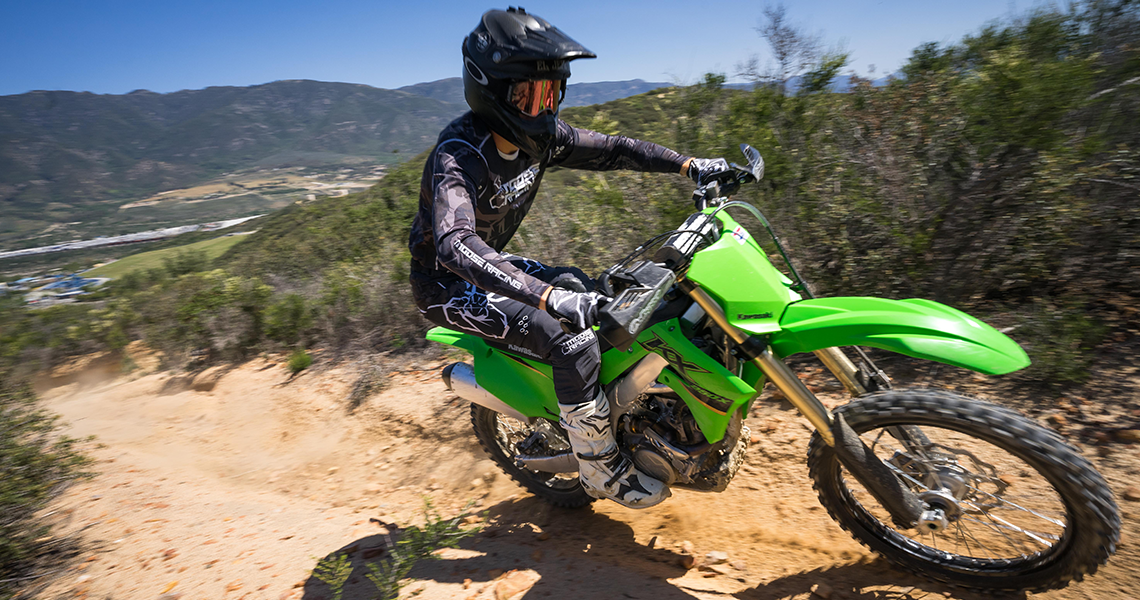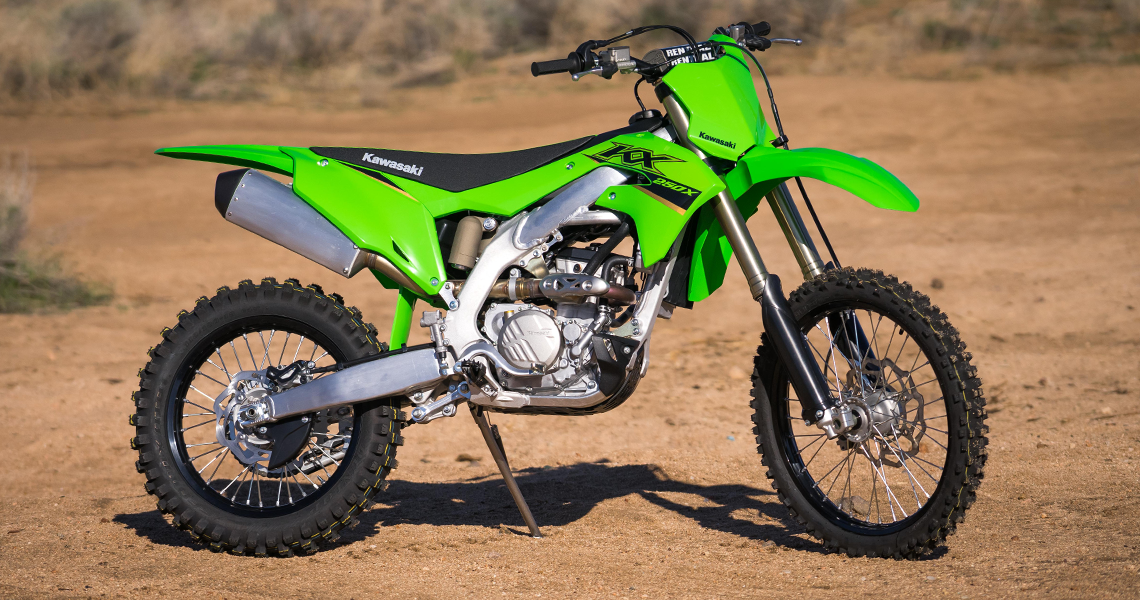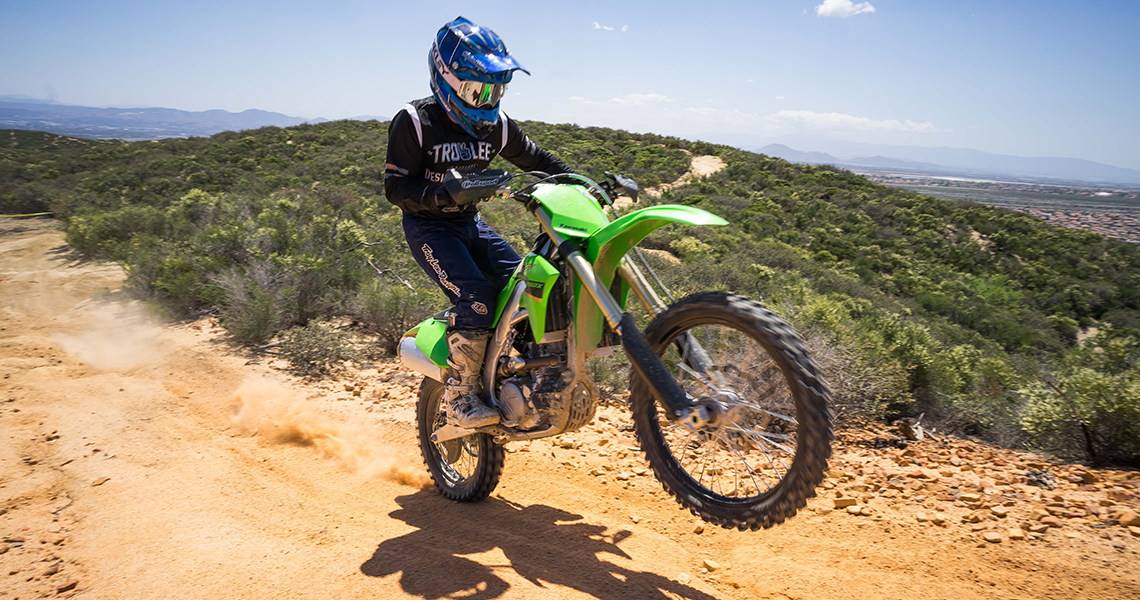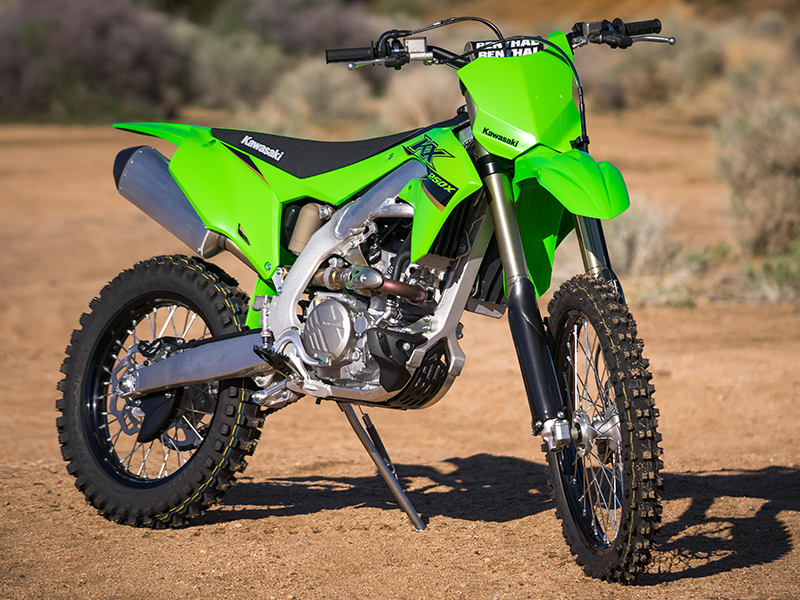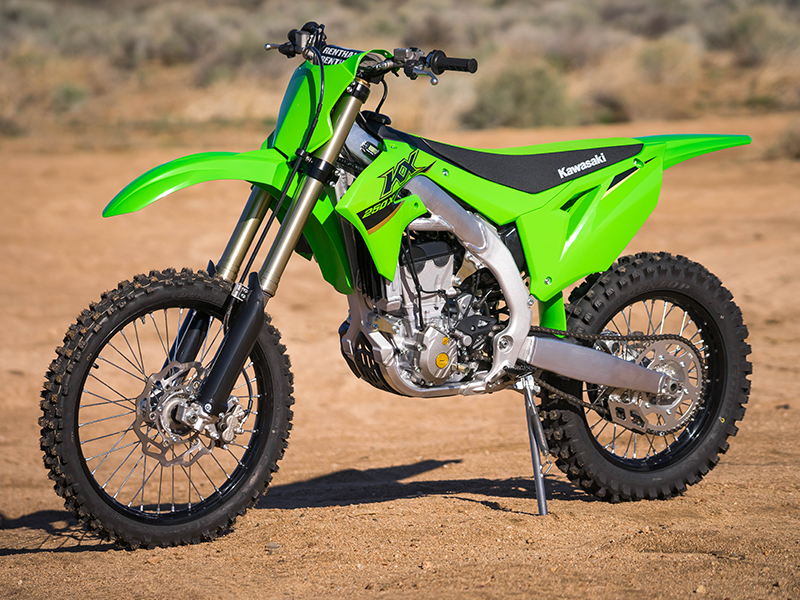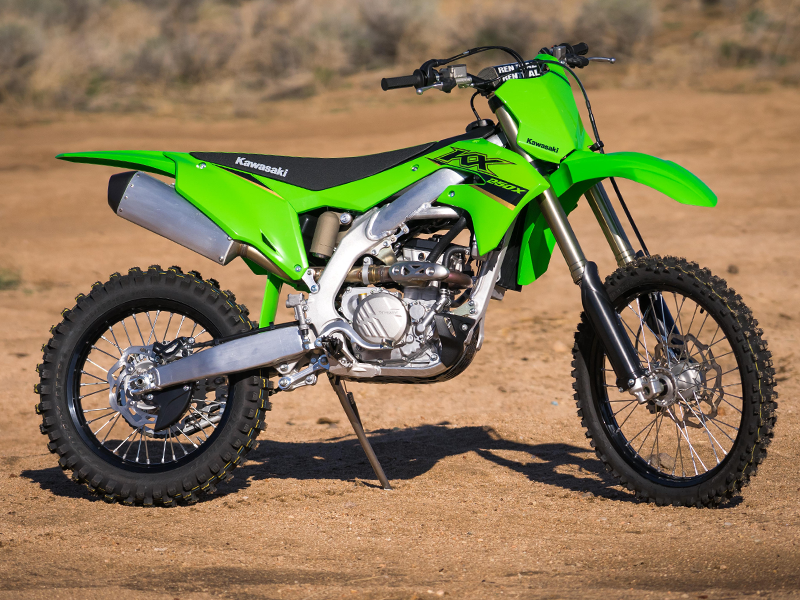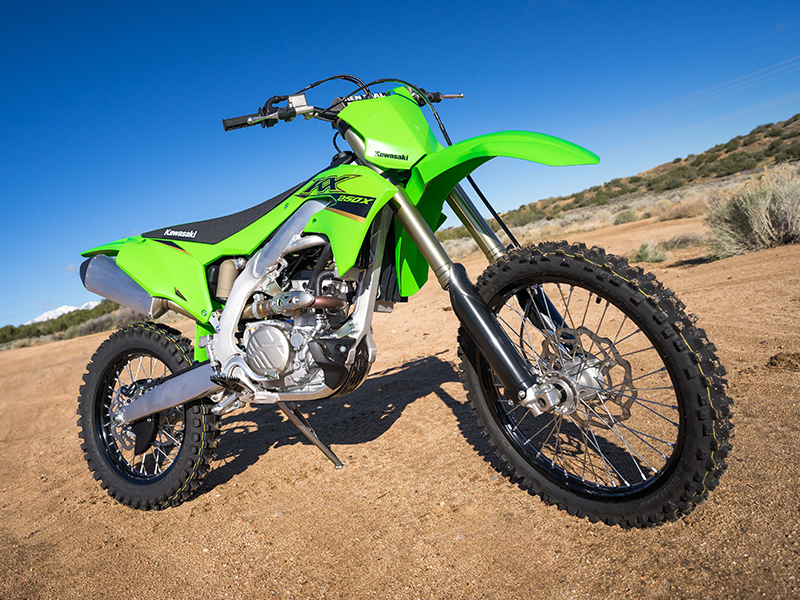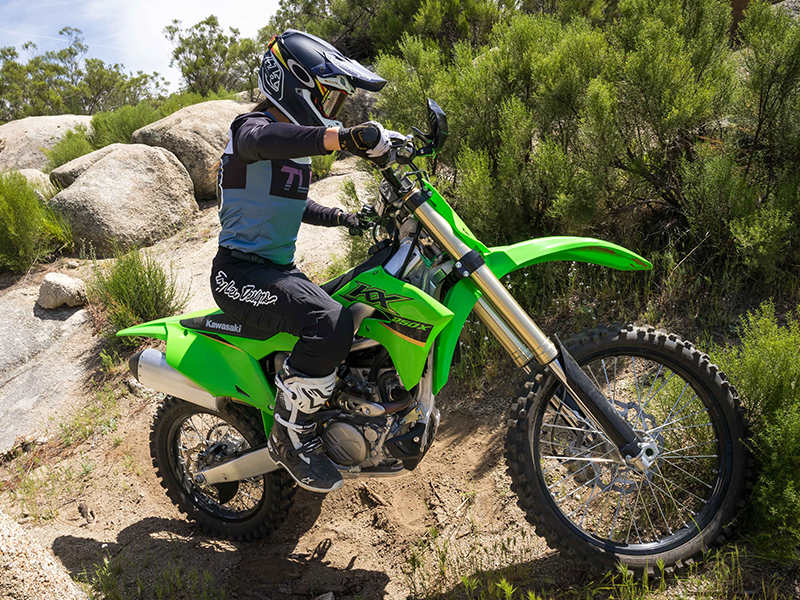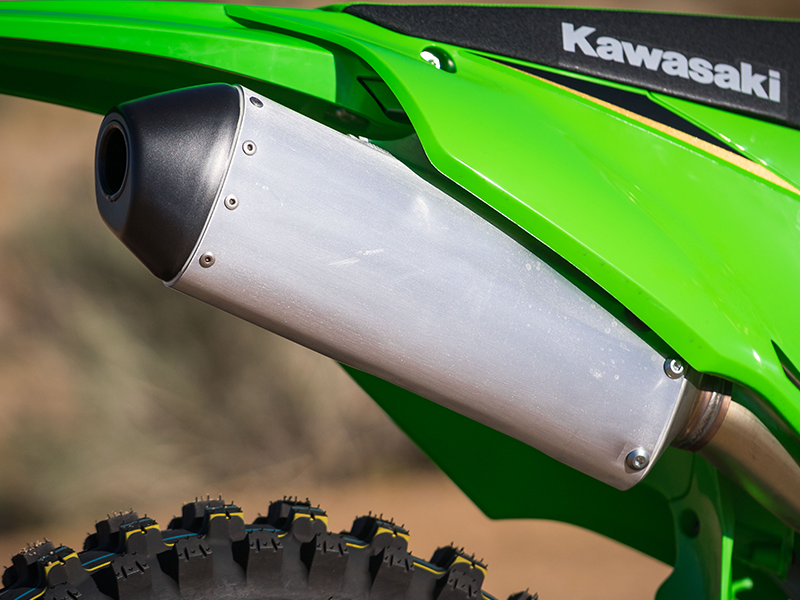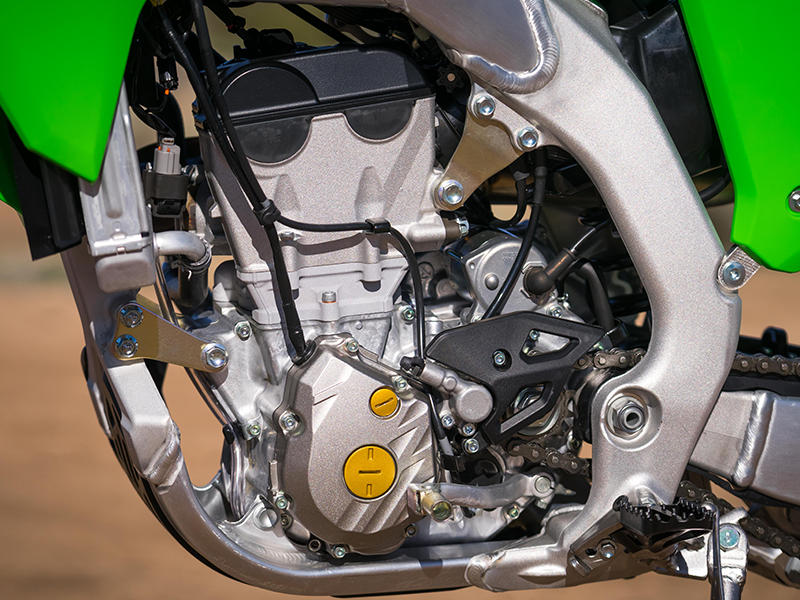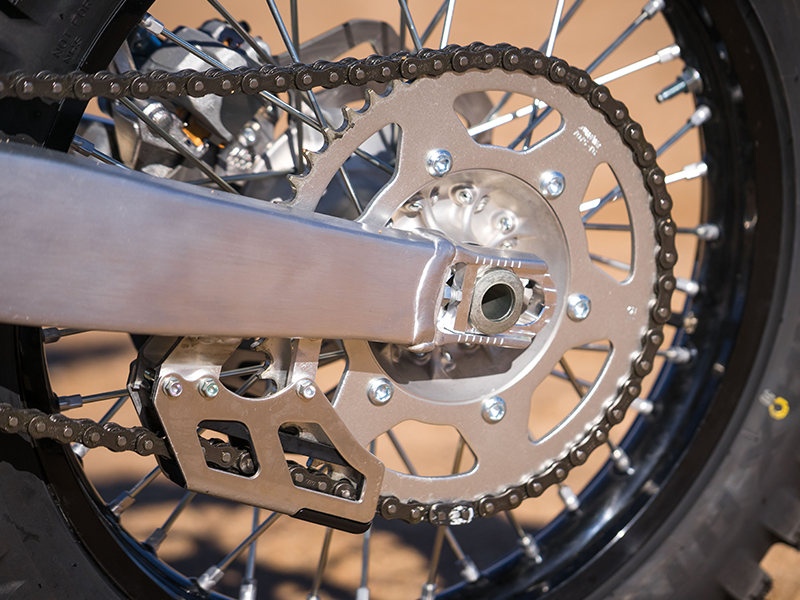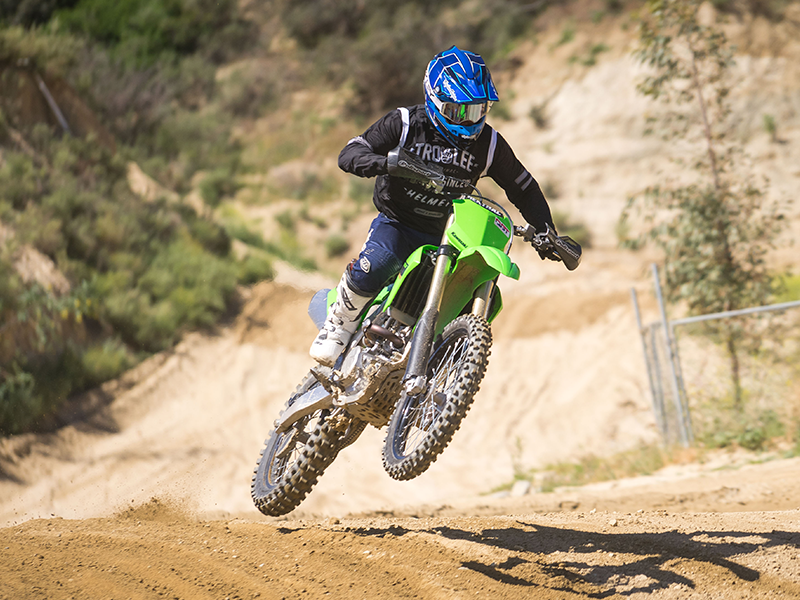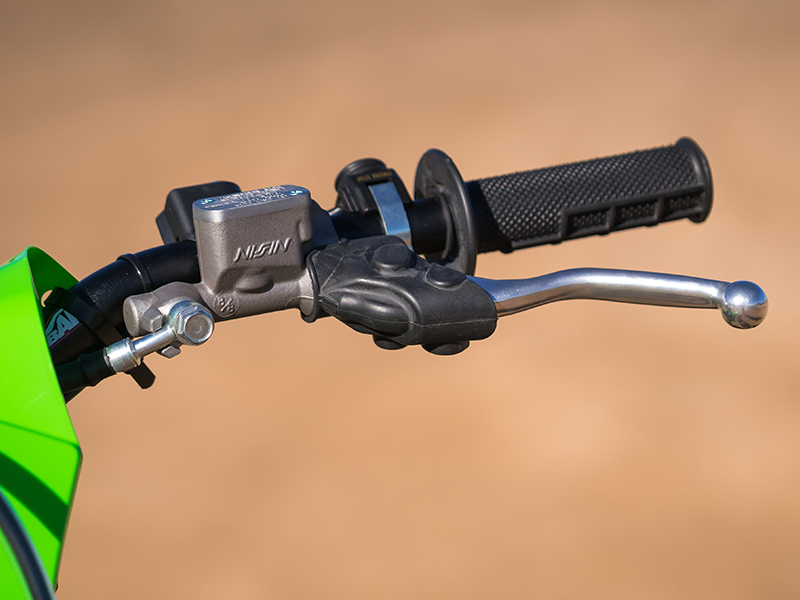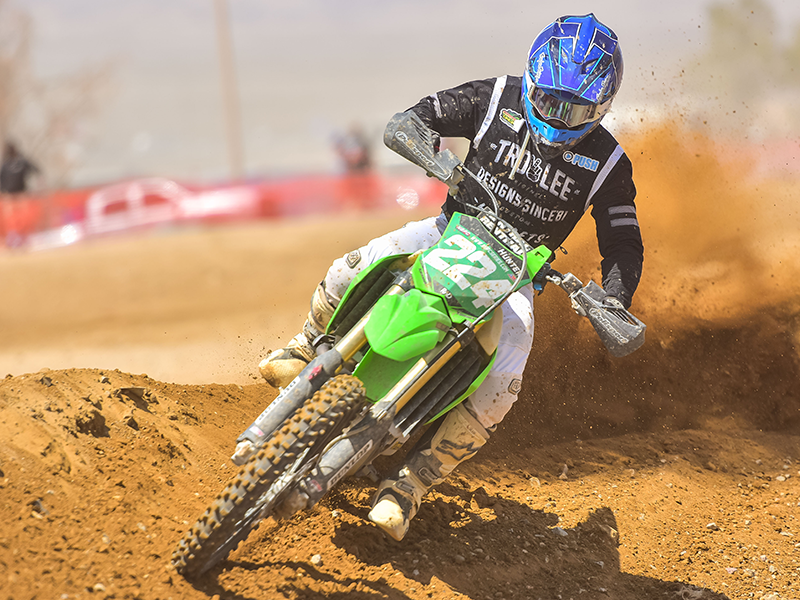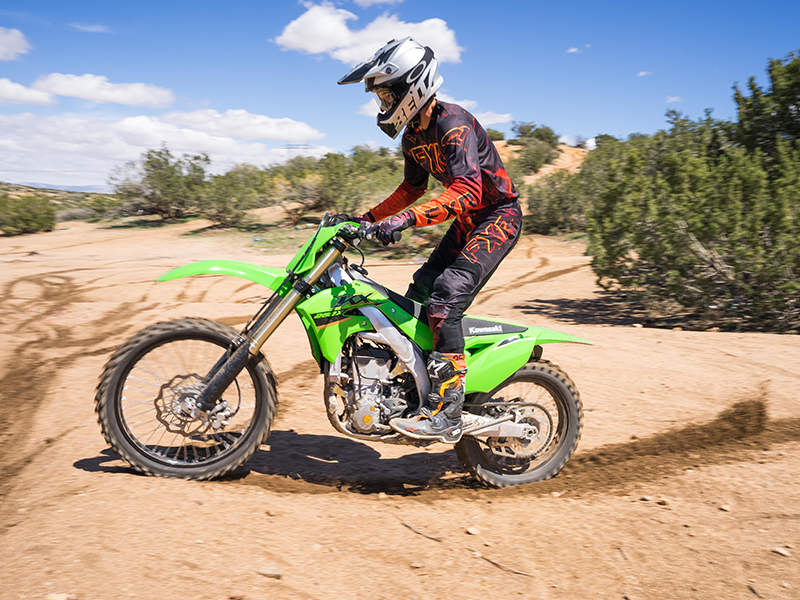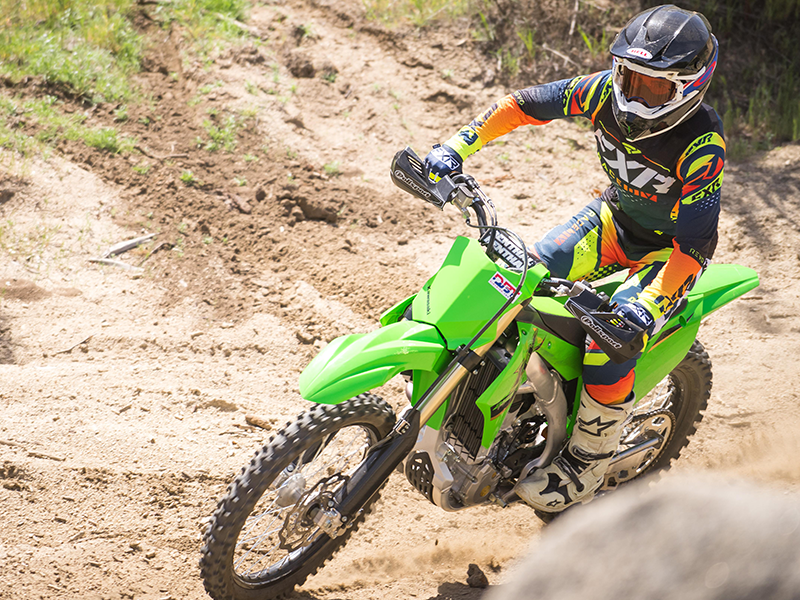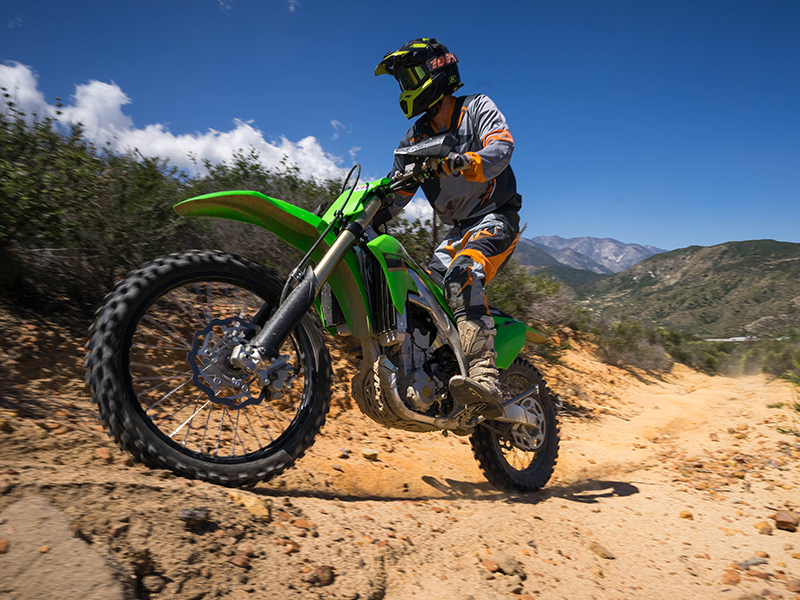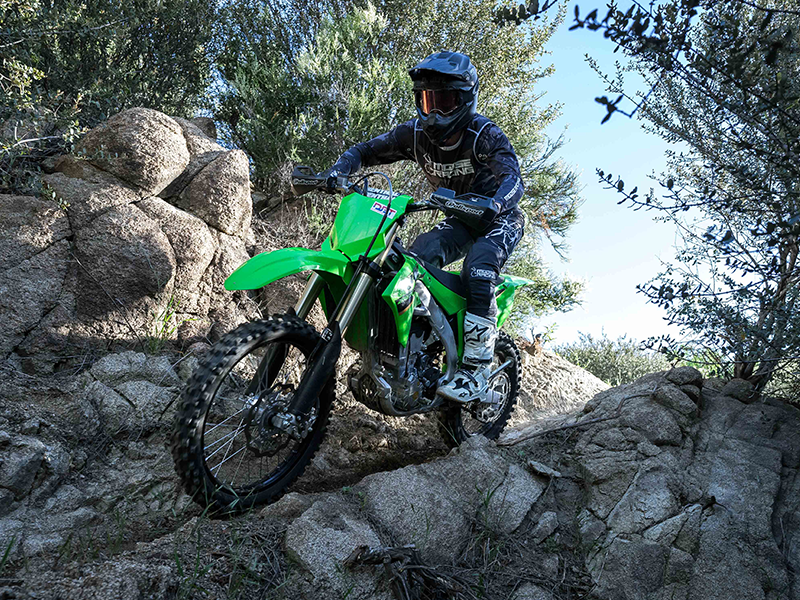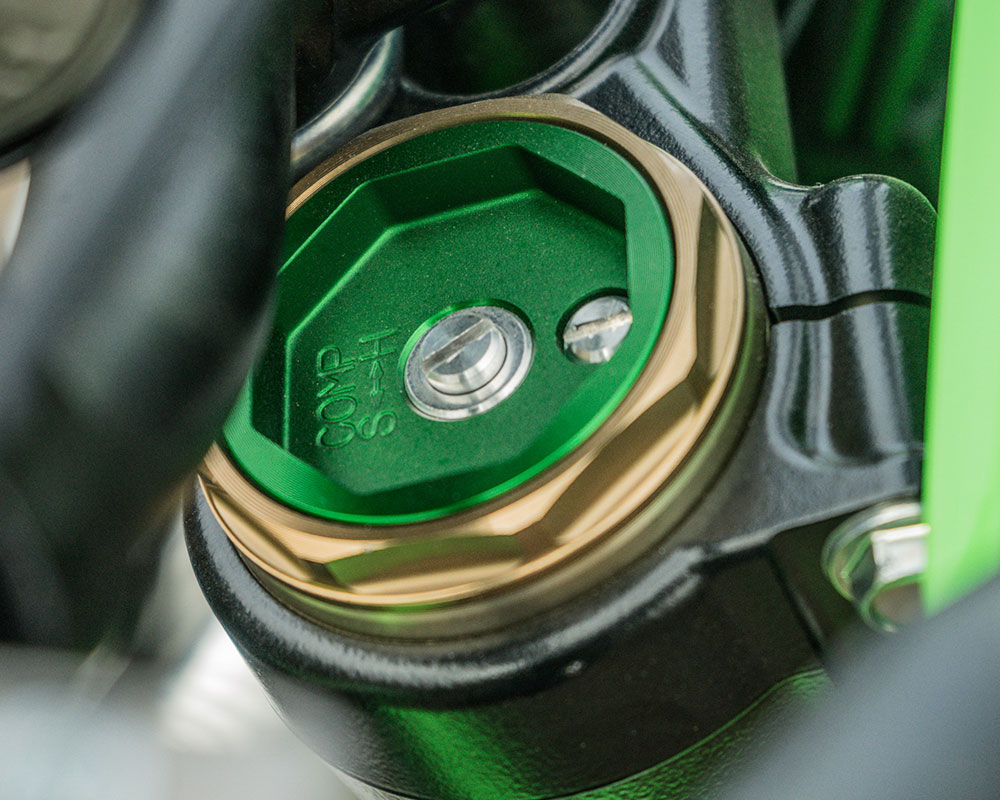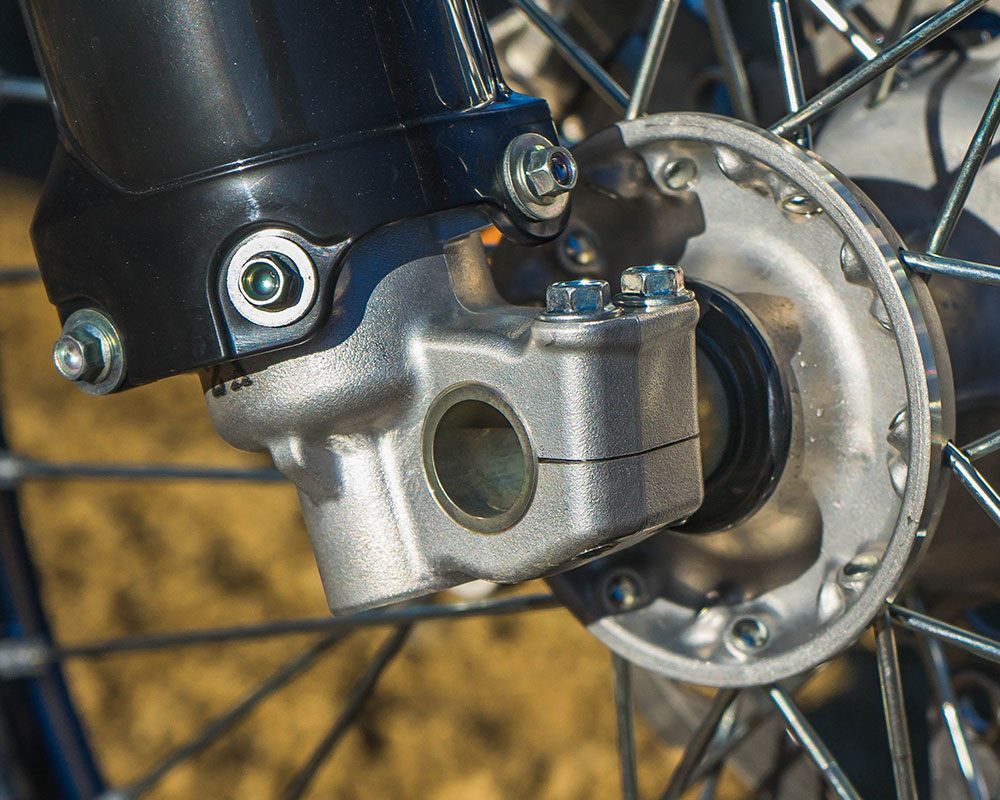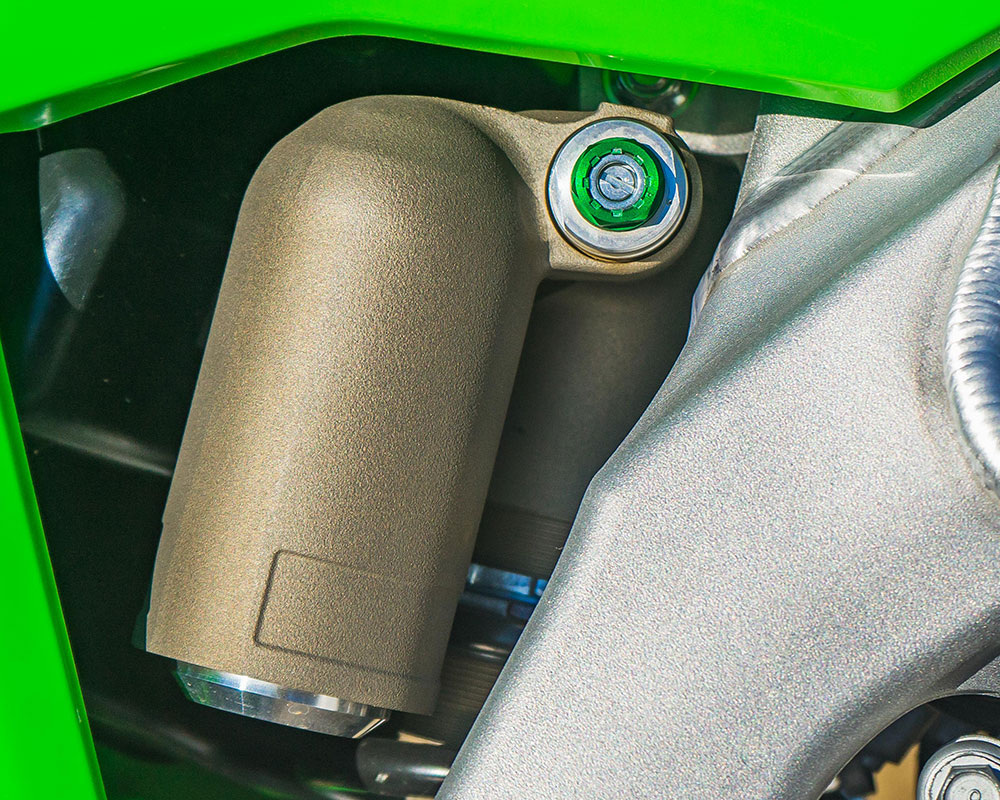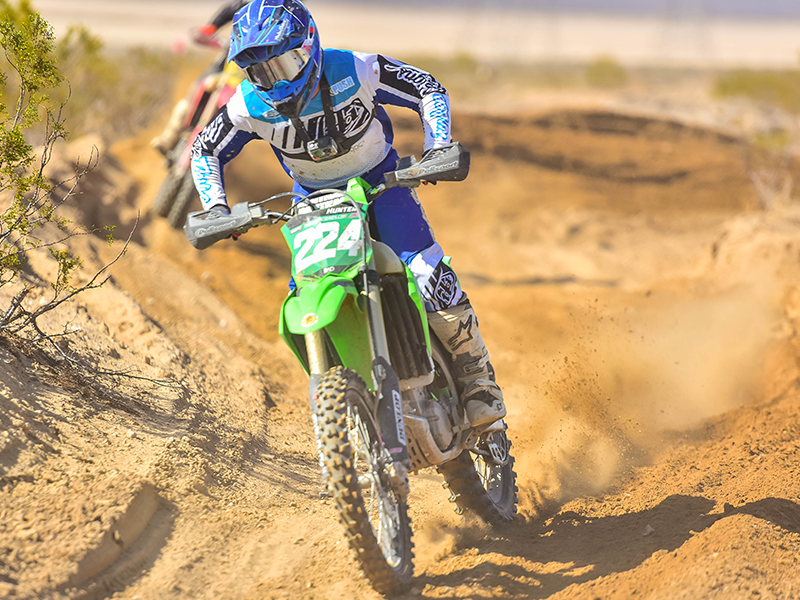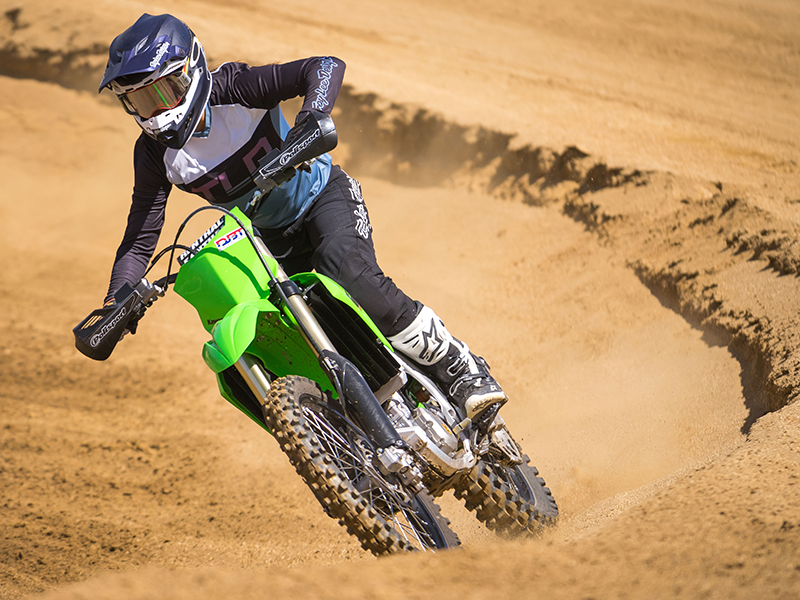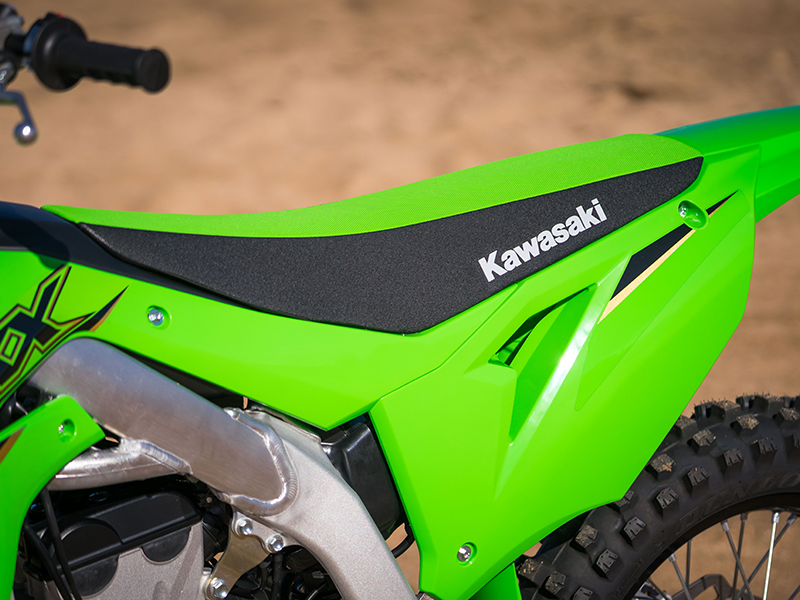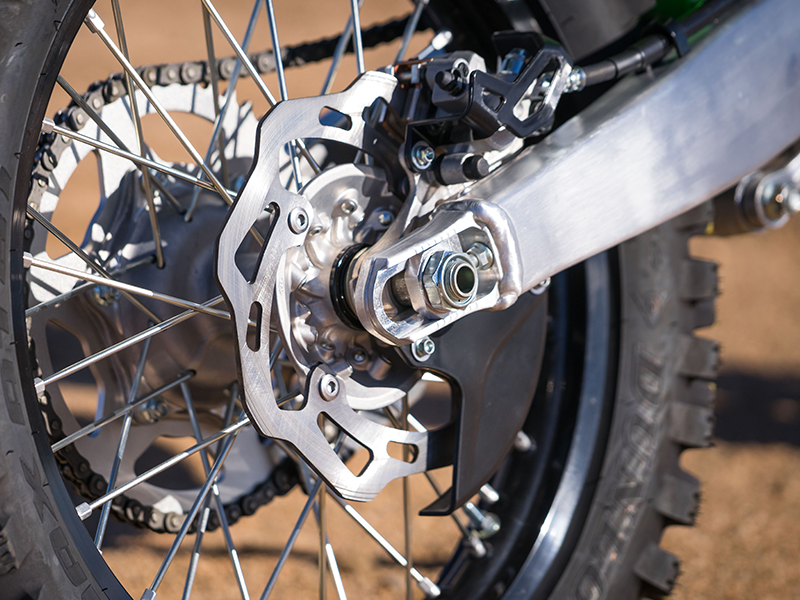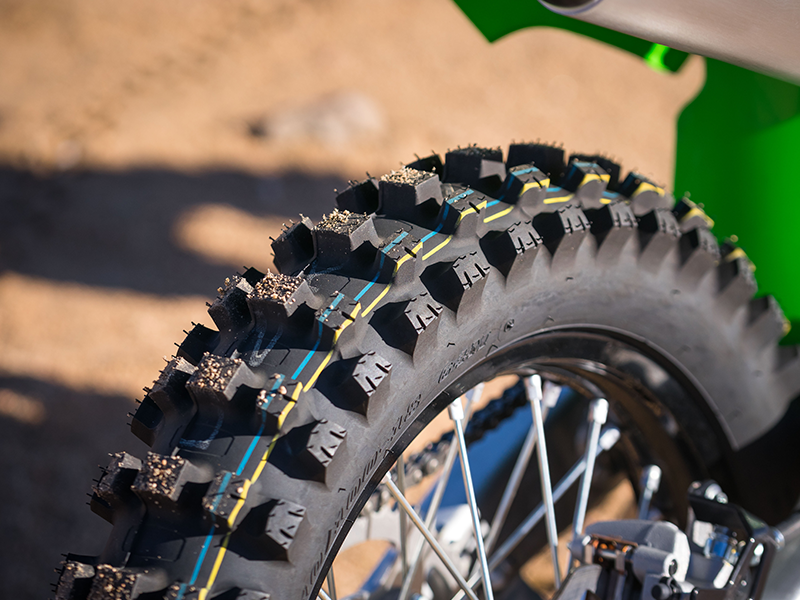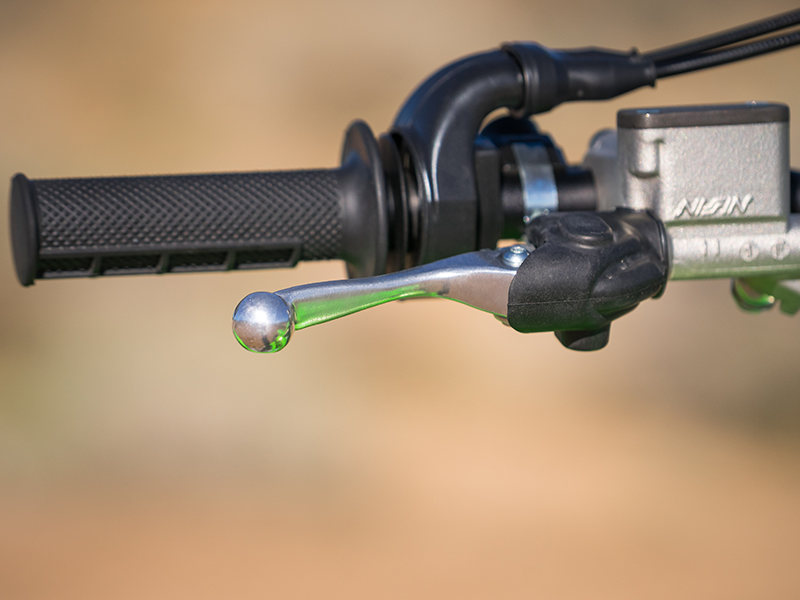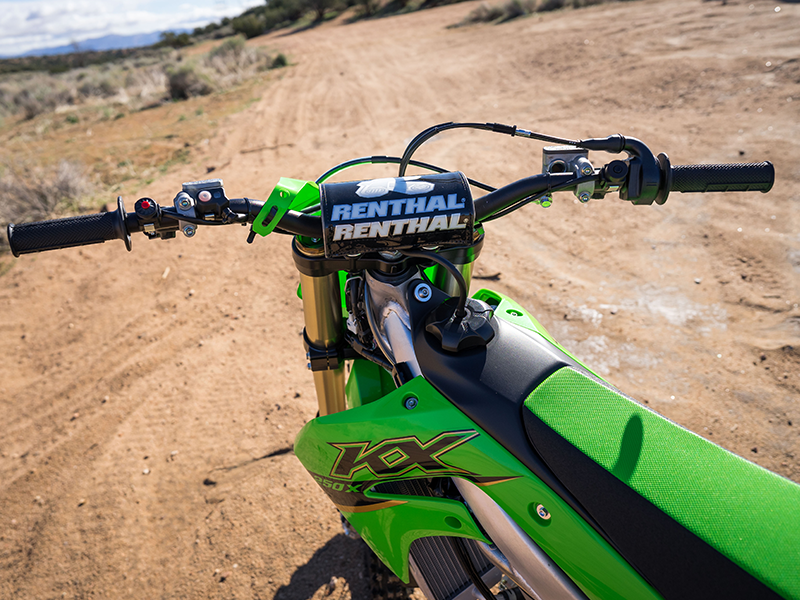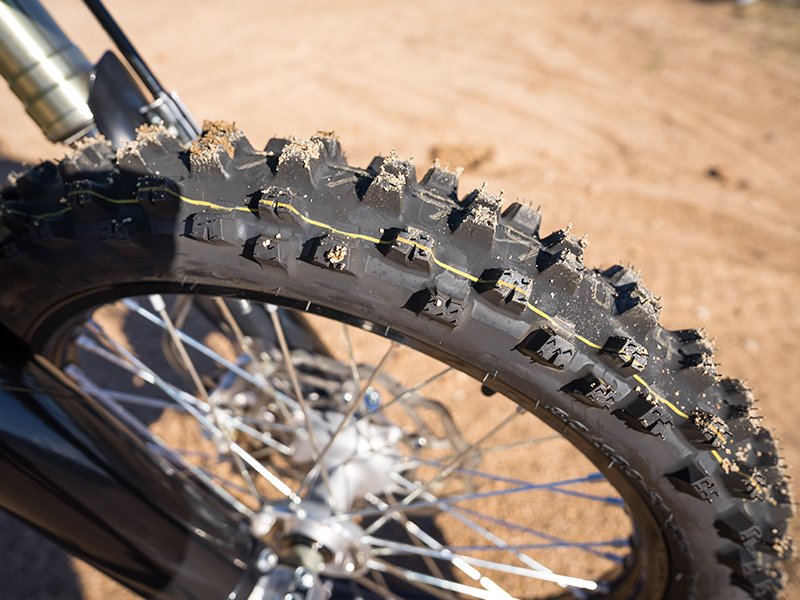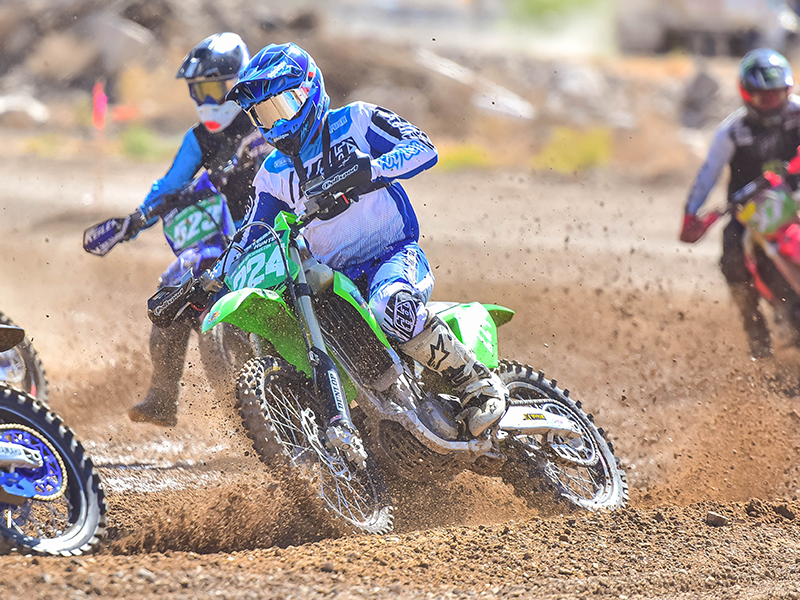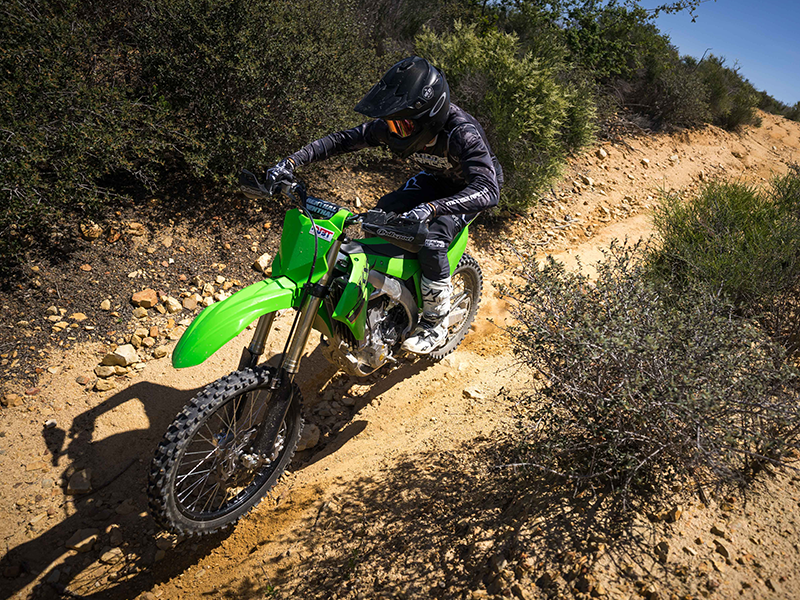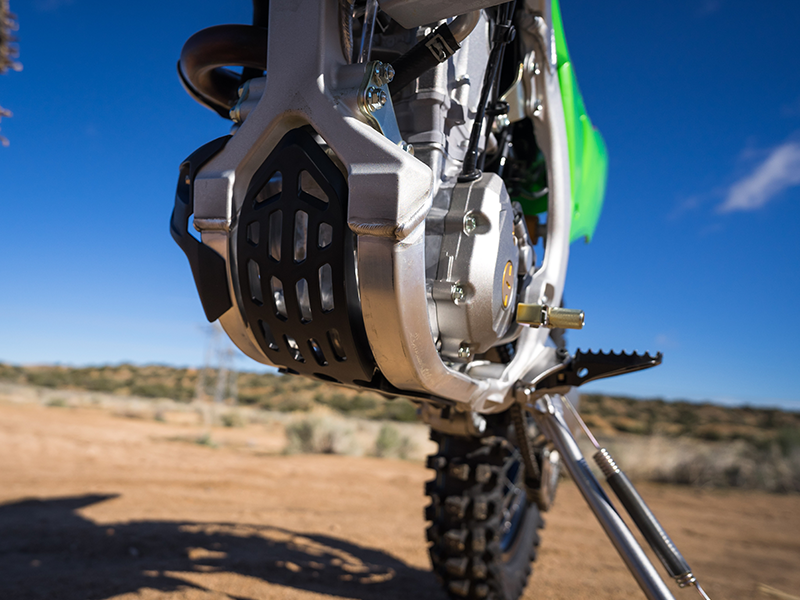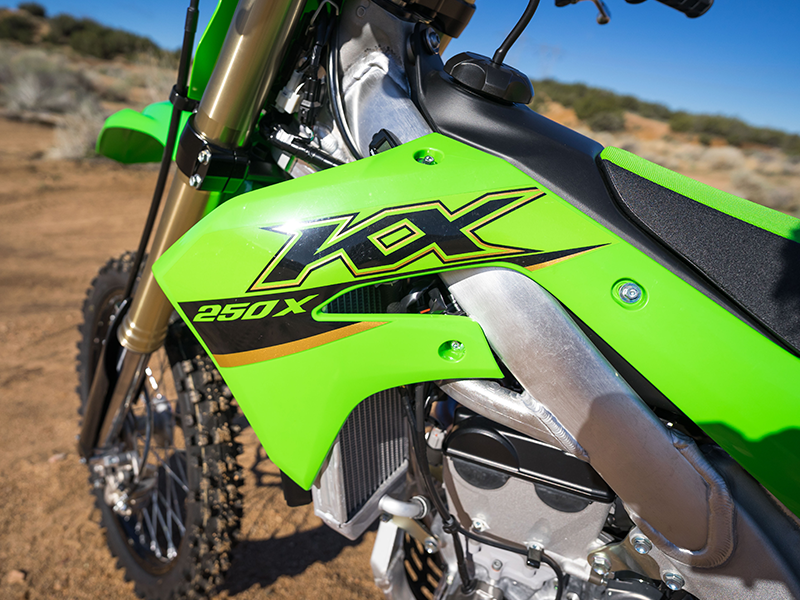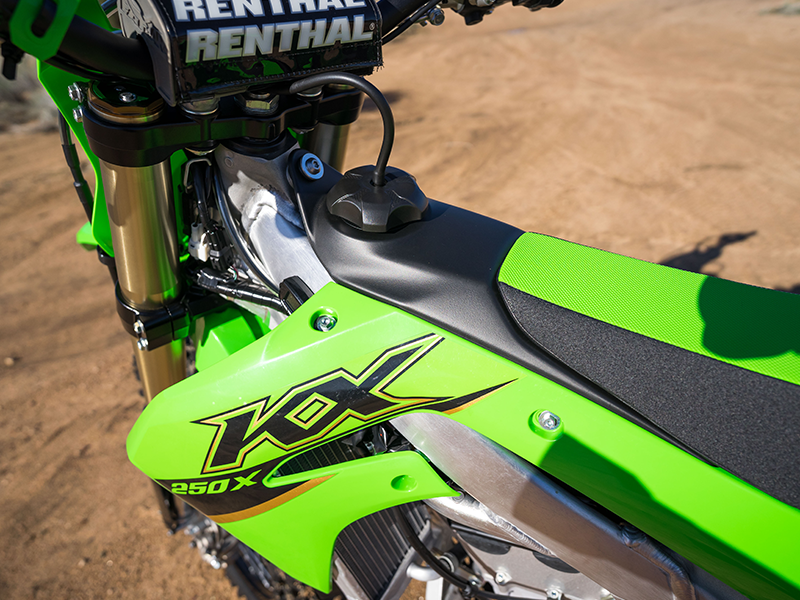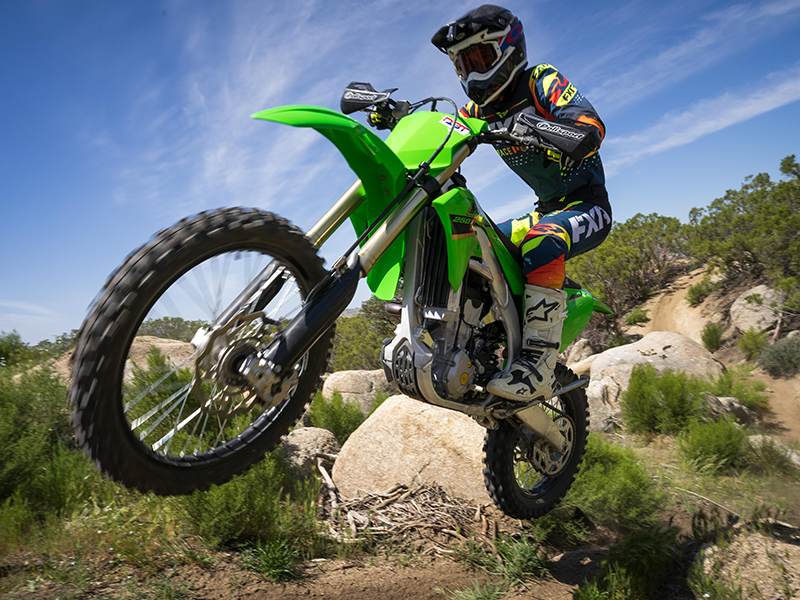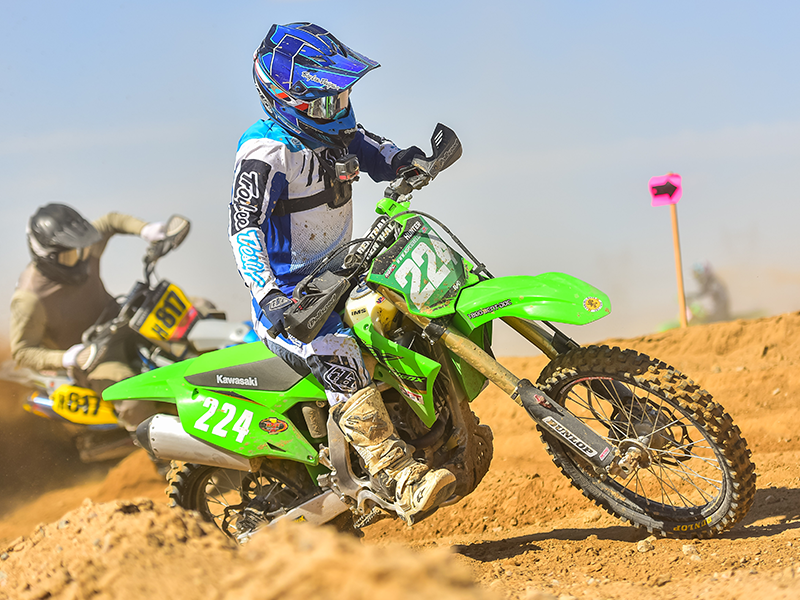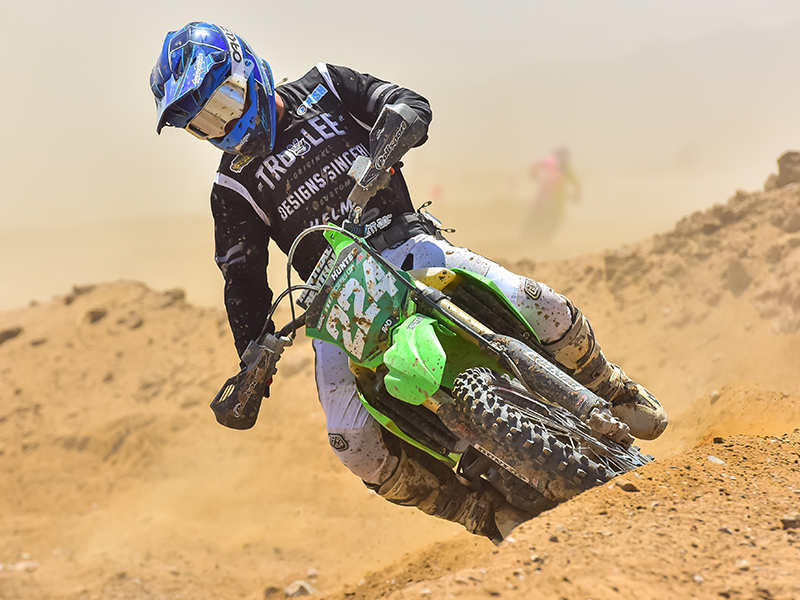2022 Kawasaki KX250X
The Thoroughbred Racer
MSRP: $8,499
- Fun, strong motor with a high revving characteristic.
- E-start and hydraulic clutch work really good.
- Light, nimble, agile feeling bike.
- Lacks some off-road necessities that most off-roaders want stock.
- Lack of on-the-fly mapping changes.
Introduction
- Kawasaki's 250F off-road racer.
- Bare bones off-road model.
Team Green has entered back into the off-road realm with their new X models, destined to be their off-road race bikes in the form of a 250cc and 450cc four-stroke. Kawasaki once dominated the off-road arena, especially out West in desert racing, but the lack of off-road offerings on the showroom floor has seen few Kawasaki’s away from the track. However, with a reinvested off-road program including the Precision Concepts Race Team on the West Coast and the Babbitt’s Team back East, and very good contingency, you now see more and more green fenders on the starting line. That brings us the KX250X, a bare-bones off-road race bike.
No changes were made from 2021 to 2022 and it still remains as a compeition based off-road racer.
Changes
- Only change is new graphics for 2022.
- All new model for 2021.
- Very similar to MX model with minimal off-road specific changes.
There is one change. That's it. Bold new graphics are the only update for 2022.
However, for 2021, changes were abundant on the KX250X. E-start, hydraulic clutch, updated motor and chassis, and new bodywork all make up the KX250X. In addition, the changes from the MX bike to the Off-Road version are short and sweet: an 18 in. rear wheel, a kickstand, slightly softer fork settings and springs, a larger rear sprocket, and the “Mellow” mapping coupler are equipped stock.
The engine updates were mainly focused in the top end, where a longer connecting rod can be found inside the crankcase. Additionally, a new frame that resembles the KX450 and the KX450X houses the updated engine with electric starter and new bodywork. KYB components handle the bump absorption on the 250 while a new linkage has been developed for 2021.
Power
- Top-end heavy motor.
- Free-revving, exciting power.
- Three different mapping couplers.
- Likes to be revved and is easy to rev.
The 250F class is often dominated by a strong motor package and Kawasaki is bringing a competitive platform to the small-bore class. The 250cc four-stroke powerplant has a decent bottom and enough torque to get by, but it struggles compared to the best in the class. However, as the RPMs build, the motor really comes to life. Similar to the KTM and the Husky, it has a linear powerband where there are no big surges or drop-offs, but a strong climb from bottom to top where you seemingly never can find the rev limiter. Our rule of thumb aboard this bike is when you think you need to shift, count to three. At that moment you’ll find the magic in the 250X motor. If you’re one who likes to short shift and is smooth with the power, it’ll be difficult to ride this bike to its full potential. Nonetheless, if you’re aggressive on the throttle and don’t mind floating the valves to go fast, this motor package will keep you satisfied.
The different mapping couplers make a big difference in how the power is delivered and most can find one that they agree with. The mellow coupler is good when traction is at a premium and you’re looking to keep the rear wheel hooked up and the RPMs a little lower. It doesn’t rev out all that much, but it offers a smooth and easy-to-ride powerband. The aggressive coupler boasts a quick, free-revving feel that the higher the RPMs, the more power it’s putting out. While it is kind of counterintuitive, lazy riders can find some positives with this mapping as the need to shift isn’t apparent. They can simply come out of a corner and wait until the last possible second to shift without sacrificing power. Finally, the standard coupler is a good mix of both and transitions well throughout a variety of terrains. As the average speed goes up, the better the next coupler in the lineup works.
In the transmission, Kawasaki uses the same 5-speed MX transmission which isn’t necessarily a bad thing. For those that are GP racers and frequent the track a lot, this is a welcomed offering. The spacing is tight with no big gaps, which helps keep the bike in the meat of the power at all times. However, when the speeds go up, you run out of gear pretty quickly. In the desert and faster GP courses, top speed isn’t nearly enough, and when you try trail riding the bike, you have to cruise around fire roads at best to not be bouncing off the rev limiter at all times. For desert and GP riding/racing, we’d suggest dropping a tooth or two in the back to get a little extra top speed. The hydro clutch has a really nice and progressive feel to it similar to a good working cable clutch pull, and it can be handy when the speeds decrease and you need to keep the bike from stalling. We aren’t heavy clutch abusers here at DBT, but we’ve come to find good life out of the KX clutch thus far.
With some experience changing mapping, there is a lot more potential in the bottom-mid range. Precision Concepts remapped our stock ECU and, paired with the green coupler, it helped unlock the missing power down low. Likewise, the top end is still great and can hang with just about any 250F in faster conditions -- that is until you run out of gears. In faster conditions, a 50T rear sprocket helps widen the spacing and get that little extra top end needed.
Suspension
- Stiffer suspension setup.
- Expert level GP/Intermediate level MX settings.
- Balanced feel.
Setting up suspension on an off-road bike is nearly impossible from a manufactures standpoint. The same bike is being bought and ridden by riders hitting Baja whoops at 70MPH+ and splitting trees at a local enduro in Mississippi at 10MPH. Two very different scenarios that require two very different suspension settings. Often, OEM’s will cater to the east coast based crowd since they represent the majority, and truthfully, many western off-roaders can and do rely on MX models for their racing needs due to the similarities between the two disciplines.
However, Kawasaki has setup this bike as more of a West Coast/GP race bike and retained a similar feeling to the MXer in the suspension department. The KYB components have a stiffer nature on this bike and handle faster, rougher sections that we might typically see on one of our rides in SoCal. We ran the sag at 105mm for stability without sacrificing cornering.
Our fast, aggressive riders who prefer moto-style/stiff valving really liked the stock settings as a good GP setting. In stock trim, the forks are a little stiff initially but retain really good bottoming with a nice progressive feel through the stroke. In the rocks and slow speed situations, there is little deflection and the stiffer nature has enough plushness to soak up the small chop and chatter. In the larger braking bumps and under a heavy load, it resists bottoming with no harshness or weird quirks. Even when transferring over to a moto track, it holds up really well and can take the abuse of over-jumping/casing jumps without doing anything scary.
Our vet riders who also pack a few extra pounds found the suspension to be a little too soft, but the bike is way under sprung for those riders. The need to perfectly downside jumps and hit big sand whoops perfectly drastically increases, but this isn't necessarily a vet rider's specialty. With the right springs, the suspension would hold up much better and suit their needs well. Still, those riders can appreciate the handling of the bike.
Overall, the suspension is very confidence-inspiring. Unlike most off-road bikes, it has a lot of hold up and “safety” built in, meaning you can charge hard into big whoops, breaking bumps, jumps, etc. and the bike will soak it up. To get a little more comfort out of it without sacrificing performance, we softened up the low-speed compression 2-3 clicks on both ends and sped up the rebound 1-2 clicks on the fork depending on the rider.
We raced this bike in a rough, sandy National Grand Prix in Primm and with very minimal clicker changes, the bike held up well to finish inside the Top 10. Though it was a tad soft for the deep conditions, it goes to show how far stock suspension has come and how capable it truly is.
Chassis - Handling
- Light, nimble, agile handling.
- Motor and suspension compliment each other.
- Cornering is adequate.
The Kawasaki retains a moto bike feeling when out on the track and trails which is no surprise. The lack of changes suggests it should feel quite similar to the KX250, and that it does. It is very light and agile feeling, and the ergonomics help further this feeling. The seat is very flat and firm, keeping you sitting on top of the bike, not in it. Additionally, the bike feels very narrow from front to back, making moving around very easy, almost too easy. Taller riders tend to prefer to move the handlebars in the forward hole with the mounts facing the back direction in position 3. Also, some liked to move the footpegs in the lower position. The adjustability is a really nice feature that the Kawasaki’s have, and it helps riders of all sizes find a comfortable setting without having to go out and buy additional parts.
The nimble chassis really shines in corners and in tight terrain. You can simply point and shoot in which ever direction you’d like and the bike will follow suit. The stiffer suspension also assists in this as it is more responsive to weight shifts through the pegs and handlebars. With that being said, tt doesn’t feel quite as planted as a Yamaha, but more nimble similar to a KTM/Husky. We experienced some headshake and deflection when speeds increased, but it was nothing death defying.
The bike comes with Dunlop AT81 tires front and rear, and we aren’t particularly fans of those tires. They have a stiffer sidewall and add some unnecessary harshness to this bike, or any bike for that matter. Additionally, front end traction isn’t great in most conditions. We played around with other tires like Maxxis SI’s, Dunlop MX53’s, and Kenda Washougal’s and all of them improved the bike. When we swapped out tires, it felt as if we backed out the compression clickers a couple clicks with some added comfort.
Maintenance has been fairly simple, although we haven’t had to do much! Air filter changes are done through the left side plate, with just two simple bolts keeping you from it. It’s no class leader in easy maintenance, but it is slightly better than trying to fumble through the seat and drop a bunch of dirt in the air boot. Still, we found ourselves having to clean out the boot from dirt falling in while pulling the dirty filter out. Oil change is simple with the drain bolt on the bottom of the case and the oil filter easily accessible on the side case.
While we don’t necessarily hate that the KX250X very closely resembles the KX250, some more off-road features would be nice in stock trim. Simple things like handguards, a more protective skid plate, and a larger fuel tank would be really nice. Some off-road racers will buy these parts anyways, so having them stock on a bike isn’t completely necessary, but it’d be really nice to feel comfortable racing a bike in stock trim. We attempted to race a 60 minute GP at Glen Helen, but at the 55 minute mark, we started pushing our bike due to a lack of gas. Also, the kickstand isn’t the best engineering we have seen. It is very big and bulky, and almost every rider that touched the bike noted the kickstand getting in the way of their left leg.
We found adding a larger capacity tank actually helped with front end traction in corners, as it suffers from a light, vague feeling and can tend to wander mid corner. Even with a larger IMS tank, it still is playful and nimble, acting very responsive to movement through the pegs.
Conclusion
- Race inspired, aggressive bike.
- Lacks some off-road necessities.
- Benefits from an oversized tank.
- ECU remap helps unlock bottom-mid power.
Kawi’s re-entry into the off-road racing segment is on par with modern times. Racing, especially on the West Coast, sees higher speeds and resembles motocross racing more and more with groomed terrain, and this bike suits that style. It comes with some of the basic off-road necessities, though it still lacks some of the basics like a larger fuel tank and handgaurds.
The bike screams aggression, from the motor to the suspension and handling. It likes to be ridden fast and hard, which makes it a fun bike to ride and race. With just a few simple changes, we have made it a potent off-road GP racer. A larger tank and an ECU remap were all that were needed to put this bike into the top 10 of a Pro 250 National Grand Prix.
Recent Product Tests
Leave a Reply
